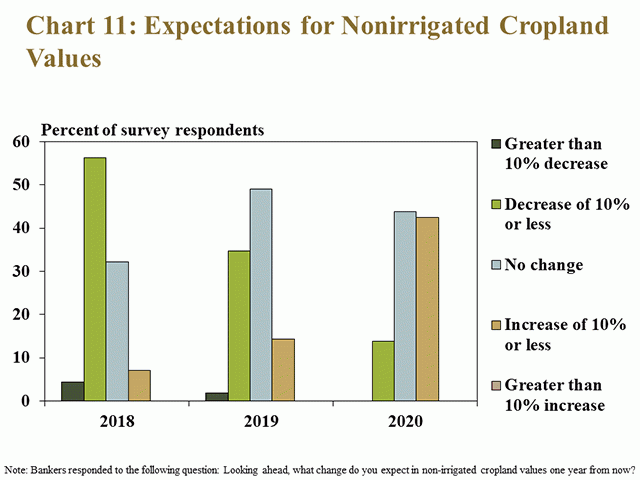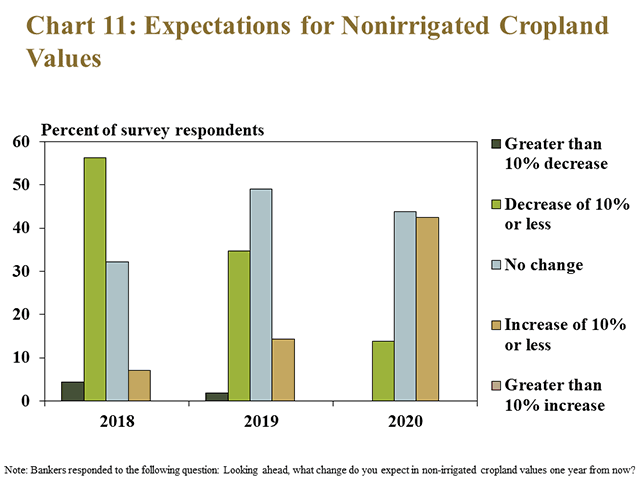Minding Ag's Business
Consensus Builds: Farmland Values Are Looking Up as Incomes Rise, Interest Rates Fall
MT. JULIET, Tenn. (DTN) -- Federal Reserve system banks -- covering a swath of the country stretching from Montana to Indiana -- report strengthening land values and improving credit conditions, although the Kansas City and Chicago branches both mentioned regions that rely more heavily on cattle production aren't seeing the same boom that's occurring in crop regions.
The Federal Reserve Bank of Chicago noted in its quarterly letter that agricultural land values increased 6% in 2020, the largest gain since 2012. Its survey of bankers found that 58% think land values will continue to rise through at least March, and 42% expect then to be stable. No one said they anticipate land values to decline. The Chicago Fed district covers all of Iowa as well as parts of Illinois, Indiana, Michigan and Wisconsin.
The Kansas City district is more geographically diverse, encompassing all of Colorado, Kansas, Nebraska, Oklahoma and Wyoming as well as parts of Missouri and New Mexico. Yet, the value of all types of agricultural land increased by an average of 4% compared to the prior year, the highest average quarterly increase since 2014. The outlook is more notably optimistic than recent years, with less than 15% of bankers anticipating non-irrigated cropland values to decline in the next year, while more than 40% see prices increasing.
The Minneapolis Federal Reserve Bank also reports stronger farmland values and higher cash rents. Non-irrigated cropland increased an average of 3.6% and irrigated land increased 6.9% across the district, which spans from the Upper Peninsula of Michigan and northern Wisconsin to Montana. Cash rents climbed by 6.2%.
"Increases in commodity prices at the end of 2020 and robust support from government payments boosted economic conditions in the agricultural sector in the fourth quarter," wrote Nathan Kauffman, vice president of the Kansas City Federal Reserve, and Ty Kreitman, assistant economist, in their post. "A majority of bankers in the District indicated that farm income was higher than a year ago for the first time in eight years, boosting liquidity and loan repayment capacity, and providing renewed support for farm real estate. Overall, agricultural conditions in the first quarter of 2021 in the Kansas City Fed region were poised to remain strong for the first time since 2013."
The notable exception is in cattle country, where the higher dependence in livestock revenues and increased drought pressures lowered bankers' optimism, like Oklahoma and the Mountain States. "In fact, about 30% of respondents in those states indicated that incomes were lower than a year ago, compared with only 8% in all other states."
P[L1] D[0x0] M[300x250] OOP[F] ADUNIT[] T[]
The economists in Chicago and Kansas City both noted that livestock prices in general were lower in December 2020 than the year prior, but that they'd made up ground since the peak of the pandemic. David Oppedahl, the Chicago Federal Reserve's senior business economist and author of its AgLetter, noted that $2.3 billion of Coronavirus Food Assistance Program payments were made to livestock producers in his district, about 40% of the total payments to the region.
Other interesting takeaways from the two publications:
-- As of Jan. 1, 2021, the average interest rate for a farm operating loan in the Chicago district was 4.49%, feeder cattle loans 4.66% and ag real estate loans 4.1%. All are the lowest in the history of the survey.
-- Loan volumes in the Chicago district are expected to be larger in the first quarter of 2021 than compared to the same quarter a year earlier. "Yet the mix of agricultural loan types was expected to change: Farm machinery and grain storage construction loan volumes were anticipated to increase, while the volume for operating loans was anticipated to be flat."
-- In the Kansas City district, larger-than-expected incomes are likely to be channeled into stronger balance sheets as well as new capital purchases. "About 60% of respondents listed paying down farm debts or machinery purchases as likely uses of extra income. Slightly less than half indicated improving working capital also would be a priority and a smaller share anticipated other types of spending." Lower on the list: buying real estate or making improvements to real estate.
Both of these comments reinforce last week's Minding Ag's Business blog, "Brighter Financial Outlook Boosts Interest in New Equipment," which can be found here: https://www.dtnpf.com/….
The full text of the Kansas City Federal Reserve's finding can be found here:
https://www.kansascityfed.org/….
You can read a copy of the Chicago Federal Reserve's most recent AgLetter here: https://www.chicagofed.org/….
The findings of the Minneapolis Federal Reserve Bank's credit survey can be found here: https://www.minneapolisfed.org/….
Katie Dehlinger can be reached at: katie.dehlinger@dtn.com
Follow her on Twitter @KatieD_DTN
(c) Copyright 2021 DTN, LLC. All rights reserved.





Comments
To comment, please Log In or Join our Community .